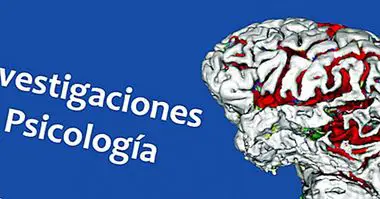The differences between hallucination, pseudo-hallucination and hallucinosis
Consciousness is a strange psychological phenomenon . On the one hand, it always appears from the hand of the perception of what surrounds us: when we are conscious, we always have proof that beyond our body there is something: shapes, colors, sounds, textures, or simply gravity.
However, these perceptions do not have to be true and, in fact, almost never are, to a greater or lesser extent. Fortunately, only in some cases does this degree of distortion of reality become so intense that it is a sign of mental pathology.
Next we will see what they are the differences between hallucination, hallucinosis and pseudoalucination , three types of ruptures with reality that can be confused by their superficial resemblance.
- Maybe you're interested: "Hallucinations: definition, causes, and symptoms"
Differences between hallucination, hallucinosis and pseudoalucination
To understand how these three types of symptoms should be distinguished, we will first review what exactly each of them consists of.
What are hallucinations?
A hallucination is a perception that has not been triggered by a real element and that is attributed to the external environment to oneself. For example, someone who listens to hallucinated voices is unable to distinguish between these and the other noises that come from the environment, simply is unable to locate who emits them.
At the same time, hallucinations are also characterized by anosognosia, the fact of ignoring that what is experienced is a symptom of mental disorder or disease.
On the other hand, although most hallucinations are auditory, they can occur in any sensory modality: visual, tactile, etc.
- Related article: "The 15 types of hallucinations (and their possible causes)"
Pseudoalucinations
In the case of pseudo hallucinations, these perceptions are also basically imaginary and do not come from a real element. However, in this case the person who experiences them is able to distinguish between the perceptions that come from the external environment and the pseudo-hallucinations, which he attributes to a source located in "his mind".
If the patient who experiences hallucinations claims to hear voices that are of the same nature as the doctor or doctor who interviews him, the sufferer presents pseudo-hallucinations, responding affirmatively and without hesitation to the question: "Do you hear voices coming from your head?" .
On the other hand, in the pseudo-hallucination, although the person recognizes that the voices, images or tactile experiences are not produced by external phenomena and consequently objectives (detectable by anyone who is nearby), considers that what happens does not indicate the presence of any mental disorder . That often does not seek help.
What is hallucinosis?
Hallucinosis is similar to hallucination and pseudo-hallucination in that in these three cases the experience is not directly produced by something that actually exists and that has the appearance that that "appearance" seems to indicate. However, the hallucination differs from the other two in several aspects.
First, hallucinosis is distinguished from hallucination in that the person knows that the experience does not come from outside It is not produced by an objective phenomenon: it is a product that only manifests itself in your consciousness and that can not be perceived by others.
Secondly, hallucinosis differs from pseudo-hallucination in that there is no anosognosia. There is a real awareness that what happens is not normal and that it is a symptom severe enough to ask for help.
What kind of diseases do they produce?
Both hallucinations and pseudo hallucinations are usually linked to psychiatric disorders, whereas hallucinosis occurs in neurological disorders.
This is so because in the first two the degree of involvement of the nervous system is so general that it affects globally all the consciousness and abstract thinking. The fact that a person does not see from the start a warning signal see, for example, a 10-meter dragon floating in the air, is itself a symptom of pathology. The same happens when you do not raise any suspicion about mental health if for days a voice is heard and you can never locate the person who issues it.
The hallucinosis, however, the degree of affectation of the disease is not so general as in hallucination and pseudo-hallucination, and focuses on specific areas of the brain, leaving the others relatively apart. This makes that hallucinosis is relatively more frequent especially in pathologies product of the use of psychoactive substances, for example.
- Maybe you're interested: "The 8 types of Psychotic Disorders"
Is it correct to use these concepts in mental health?
There are criticisms about the use of the term "pseudoalucination" , given that it has connotations that may lead to stigmatizing patients suffering from this condition.
The name suggests that the person invents the events that he describes and that he says he has experienced, something that as we have seen does not correspond to reality: although there is no stimulus as the person perceives it, this phenomenon is not a voluntary invention, something that is used only to access certain attention by the health system, for example.
That is why there are reasons to simply use the term hallucination "for these cases. Although it may seem a lie, in psychiatry and in clinical psychology appearances can come to matter a lot, especially when they affect the quality of life of patients.



















